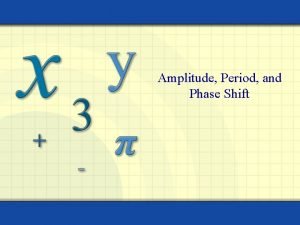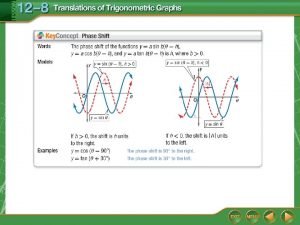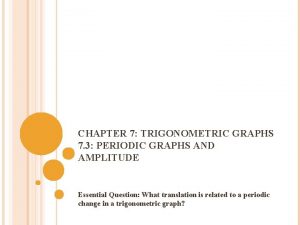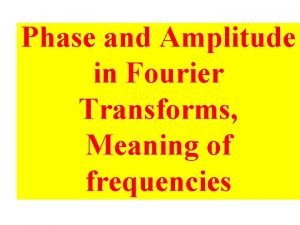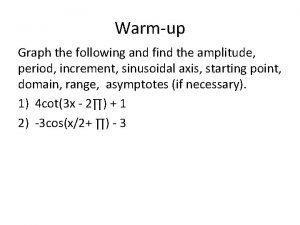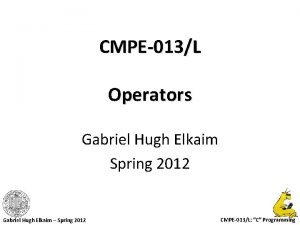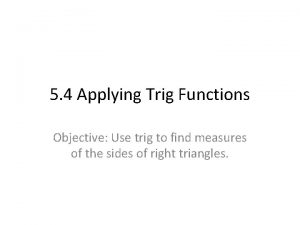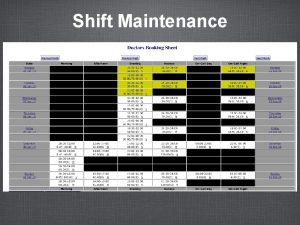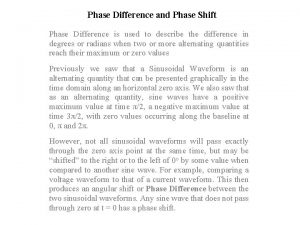6 2 Trig Functions Amplitude Period Phase Shift


















- Slides: 18

6. 2 Trig Functions Amplitude, Period, & Phase Shift 3 ways we can change our graphs

Properties of Sine and Cosine Functions The graphs of y = sin x and y = cos x have similar properties: 1. The domain is the set of real numbers. 2. The range is the set of y values such that . 3. The maximum value is 1 and the minimum value is – 1. 4. The graph is a smooth curve. 5. Each function cycles through all the values of the range over an x-interval of. 6. The cycle repeats itself indefinitely in both directions of the x-axis. Copyright © by Houghton Mifflin Company, Inc. All rights reserved. 2

Graph of the Sine Function To sketch the graph of y = sin x first locate the key points. These are the maximum points, the minimum points, and the intercepts. x 0 sin x 0 1 0 -1 0 Then, connect the points on the graph with a smooth curve that extends in both directions beyond the five points. A single cycle is called a period. y = sin x y x Copyright © by Houghton Mifflin Company, Inc. All rights reserved. 3

Graph of Tangent Function: Periodic Vertical asymptotes where cos θ = 0 tan θ θ tan θ −π/2 −∞ −π/4 − 1 0 0 π/4 1 π/2 ∞ − 3π/2 −π/2 0 π/2 One period: π 3π/2 θ

Example: Sketch the graph of y = 3 cos x on the interval [– , 4 ]. Partition the interval [-π, 4 ] on your x-axis x y = 3 cos x (0, 3) y 0 3 max 0 -3 0 2 3 x-int min x-int max ( , 3) x ( ( , 0) ( , – 3) Copyright © by Houghton Mifflin Company, Inc. All rights reserved. 5

The amplitude of y = a sin x (or y = a cos x) is half the distance between the maximum and minimum values of the function. amplitude = |a| If |a| > 1, the amplitude stretches the graph vertically. If 0 < |a| < 1, the amplitude shrinks the graph vertically. If a < 0, the graph is reflected in the x-axis. y y = 2 sin x x y= sin x y = – 4 sin x reflection of y = 4 sin x Copyright © by Houghton Mifflin Company, Inc. All rights reserved. y = sin x y = 4 sin x 6

The period of a function is the x interval needed for the function to complete one cycle. For k 0, the period of y = a sin kx is . For k 0, the period of y = a cos kx is also For k 0, the period of y = a tan kx is . . If k > 1, the graph of they function is shrunk horizontally. period: 2 period: x If 0 < k < 1, the graph of the function is stretched horizontally. y period: 2 x period: 4 Copyright © by Houghton Mifflin Company, Inc. All rights reserved.

Use basic trigonometric identities to graph y = f (–x) Example 1: Sketch the graph of y = sin (–x). The graph of y = sin (–x) is the graph of y = sin x reflected in the x-axis. y = sin (–x) y Use the identity sin (–x) = – sin x x y = sin x Example 2: Sketch the graph of y = cos (–x). The graph of y = cos (–x) is identical to the graph of y = cos x. y Use the identity x cos (–x) = – cos x y = cos (–x) Copyright © by Houghton Mifflin Company, Inc. All rights reserved. 8

Example: Sketch the graph of y = 2 sin (– 3 x). Rewrite the function in the form y = a sin kx with k > 0 y = 2 sin (– 3 x) = – 2 sin 3 x Use the identity sin (– x) = – sin x: period: 2 = 2 amplitude: |a| = |– 2| = 2 3 Calculate the five key points. x 0 y = – 2 sin 3 x 0 y – 2 0 ( , 2) x (0, 0) ( , -2) Copyright © by Houghton Mifflin Company, Inc. All rights reserved. 9

Amplitude Period: 2π/k Phase Shift: -c/k Vertical Shift Copyright © by Houghton Mifflin Company, Inc. All rights reserved. 10

Example Determine the amplitude, period, and phase shift of y = 2 sin(3 x- ) Solution: Amplitude = |A| = 2 period = 2 /K = 2 /3 phase shift = -C/K = /3 to the right Copyright © by Houghton Mifflin Company, Inc. All rights reserved. 11

Example cont. • y = 2 sin(3 x- ) Copyright © by Houghton Mifflin Company, Inc. All rights reserved. 12

State the periods of each function: 1. 4π or 720° 2. π/2 or 90° 13

State the phase shift of each function: 1. Right phase shift 45° 2. Left phase shift -90° 14

State the amplitude, period, and phase shift of each function: 1. 4. A = 4, period = 360°, Phase shift = 0° 2. A = 4, period = 720°, Phase shift = 0° 5. A = NONE, period = 45°, Phase shift = 0° 3. A = 2, period = 180°, Phase shift = 0° A = NONE, period = 90°, Phase shift = π/2 Right 6. A = 3, period = 360°, Phase shift = 90° Right 15

State the amplitude, period, and phase shift of each function: 1. A = 10, period = 1080°, Phase shift = 900° Right 2. A = 243, period = 24°, Phase shift = 8/3° 16

Write an equation for each function described: 1. ) a sine function with amplitude 7, period 225°, and phase shift -90° 2. ) a cosine function with amplitude 4, period 4π, and phase shift π/2 3. ) a tangent function with period 180° and phase shift 25° 17

Graph each function: 1. ) Copyright © by Houghton Mifflin Company, Inc. All rights reserved. 2. ) 18
 Find amplitude, period, and phase shift y=2cos(x)
Find amplitude, period, and phase shift y=2cos(x) Amplitude period phase shift
Amplitude period phase shift Amplitude trig
Amplitude trig Phase invariance
Phase invariance Amplitude and phase
Amplitude and phase Differentiate trigonometry
Differentiate trigonometry Amplitude and period graph calculator
Amplitude and period graph calculator Bathochromic shift and hypsochromic shift
Bathochromic shift and hypsochromic shift Molecular absorption
Molecular absorption Cap 221
Cap 221 Bathochromic shift and hypsochromic shift
Bathochromic shift and hypsochromic shift Difference between arithmetic shift and logical shift
Difference between arithmetic shift and logical shift Logical shift and arithmetic shift
Logical shift and arithmetic shift Gabriel hugh elkaim
Gabriel hugh elkaim Difference between arithmetic shift and logical shift
Difference between arithmetic shift and logical shift Mandibular movement
Mandibular movement Phase shift keying
Phase shift keying Qam transmitter
Qam transmitter Binary phase shift keying
Binary phase shift keying
